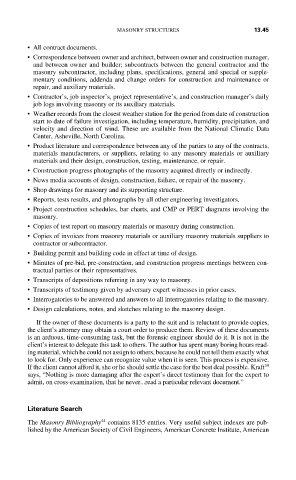Page 500 - Forensic Structural Engineering Handbook
P. 500
MASONRY STRUCTURES 13.45
• All contract documents.
• Correspondence between owner and architect, between owner and construction manager,
and between owner and builder; subcontracts between the general contractor and the
masonry subcontractor, including plans, specifications, general and special or supple-
mentary conditions, addenda and change orders for construction and maintenance or
repair, and auxiliary materials.
• Contractor’s, job inspector’s, project representative’s, and construction manager’s daily
job logs involving masonry or its auxiliary materials.
• Weather records from the closest weather station for the period from date of construction
start to date of failure investigation, including temperature, humidity, precipitation, and
velocity and direction of wind. These are available from the National Climatic Data
Center, Asheville, North Carolina.
• Product literature and correspondence between any of the parties to any of the contracts,
materials manufacturers, or suppliers, relating to any masonry materials or auxiliary
materials and their design, construction, testing, maintenance, or repair.
• Construction progress photographs of the masonry acquired directly or indirectly.
• News media accounts of design, construction, failure, or repair of the masonry.
• Shop drawings for masonry and its supporting structure.
• Reports, tests results, and photographs by all other engineering investigators.
• Project construction schedules, bar charts, and CMP or PERT diagrams involving the
masonry.
• Copies of test report on masonry materials or masonry during construction.
• Copies of invoices from masonry materials or auxiliary masonry materials suppliers to
contractor or subcontractor.
• Building permit and building code in effect at time of design.
• Minutes of pre-bid, pre-construction, and construction progress meetings between con-
tractual parties or their representatives.
• Transcripts of depositions referring in any way to masonry.
• Transcripts of testimony given by adversary expert witnesses in prior cases.
• Interrogatories to be answered and answers to all interrogatories relating to the masonry.
• Design calculations, notes, and sketches relating to the masonry design.
If the owner of these documents is a party to the suit and is reluctant to provide copies,
the client’s attorney may obtain a court order to produce them. Review of these documents
is an arduous, time-consuming task, but the forensic engineer should do it. It is not in the
client’s interest to delegate this task to others. The author has spent many boring hours read-
ing material, which he could not assign to others, because he could not tell them exactly what
to look for. Only experience can recognize value when it is seen. This process is expensive.
If the client cannot afford it, she or he should settle the case for the best deal possible. Kraft 39
says, “Nothing is more damaging after the expert’s direct testimony than for the expert to
admit, on cross-examination, that he never...read a particular relevant document.”
Literature Search
44
The Masonry Bibliography contains 8135 entries. Very useful subject indexes are pub-
lished by the American Society of Civil Engineers, American Concrete Institute, American

